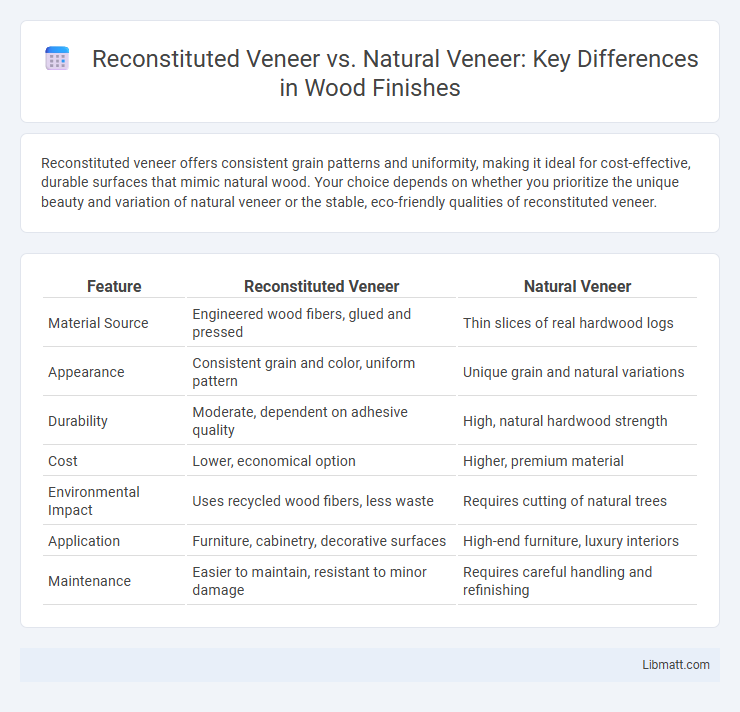Reconstituted veneer offers consistent grain patterns and uniformity, making it ideal for cost-effective, durable surfaces that mimic natural wood. Your choice depends on whether you prioritize the unique beauty and variation of natural veneer or the stable, eco-friendly qualities of reconstituted veneer.
Table of Comparison
| Feature | Reconstituted Veneer | Natural Veneer |
|---|---|---|
| Material Source | Engineered wood fibers, glued and pressed | Thin slices of real hardwood logs |
| Appearance | Consistent grain and color, uniform pattern | Unique grain and natural variations |
| Durability | Moderate, dependent on adhesive quality | High, natural hardwood strength |
| Cost | Lower, economical option | Higher, premium material |
| Environmental Impact | Uses recycled wood fibers, less waste | Requires cutting of natural trees |
| Application | Furniture, cabinetry, decorative surfaces | High-end furniture, luxury interiors |
| Maintenance | Easier to maintain, resistant to minor damage | Requires careful handling and refinishing |
Introduction to Veneers: Reconstituted vs Natural
Reconstituted veneer is engineered from thin slices of wood that are dyed, laminated, and pressed to achieve uniform grain patterns, offering cost-effective and sustainable alternatives to natural veneer. Natural veneer consists of thin slices of genuine wood, harvested from high-quality logs, preserving the authentic texture, grain, and color unique to each tree species. Both veneer types serve decorative and functional purposes in furniture and interior design, but reconstituted veneer excels in consistency, while natural veneer provides unmatched natural beauty and uniqueness.
What is Reconstituted Veneer?
Reconstituted veneer is an engineered wood product made by slicing and reassembling thin layers of wood veneers, often from fast-growing species, to create a uniform and stable surface. This process enhances durability, reduces waste, and allows for consistent grain patterns compared to natural veneer, which is cut directly from solid logs with unique, irregular grains. Reconstituted veneer offers an eco-friendly alternative that mimics the appearance of high-quality natural wood while optimizing resource efficiency and cost-effectiveness.
What is Natural Veneer?
Natural veneer is a thin slice of real wood, typically cut from logs, showcasing the authentic grain patterns and textures inherent in each tree species. It offers unique aesthetic qualities and can be sanded and refinished multiple times, making it a durable option for furniture and cabinetry. Your choice of natural veneer brings a genuine wood appearance that enhances the warmth and elegance of any interior design.
Manufacturing Process Comparison
Reconstituted veneer is made through a manufacturing process where wood fibers are shredded, bonded with adhesives, and compressed into sheets, allowing for uniformity and efficient use of raw materials. Natural veneer involves slicing thin layers from a log, preserving the unique grain patterns and character of the wood but resulting in more variability and potential waste. Understanding these differences in production helps you choose the veneer type that best suits your project's quality and sustainability goals.
Appearance and Aesthetic Differences
Reconstituted veneer offers a uniform appearance with consistent grain patterns and color tones, ideal for achieving a modern, flawless look. Natural veneer displays unique variations in grain, texture, and color, providing an authentic, organic aesthetic valued for its character and warmth. The choice between the two hinges on preference for either predictable design or distinctive, natural beauty.
Durability and Performance
Reconstituted veneer offers enhanced durability and consistent performance due to its engineered composition, making it more resistant to warping, splitting, and moisture damage compared to natural veneer. Natural veneer, while aesthetically unique with authentic wood grain patterns, tends to be more susceptible to environmental changes and wear over time. Choosing reconstituted veneer can provide your projects with greater longevity and reliable performance in demanding applications.
Environmental Impact and Sustainability
Reconstituted veneer offers a more sustainable option compared to natural veneer, as it utilizes wood fibers from fast-growing, sustainably harvested sources, reducing the need for old-growth timber and minimizing deforestation. Its manufacturing process often involves less waste and can incorporate recycled materials, lowering the overall environmental footprint. By choosing reconstituted veneer, you support responsible forestry practices and contribute to the preservation of natural ecosystems.
Cost and Affordability
Reconstituted veneer offers a more cost-effective and affordable option compared to natural veneer, as it is manufactured from wood fibers and adhesives, reducing material waste and production expenses. Natural veneer, derived from slicing real hardwood logs, tends to be pricier due to the limited supply and higher processing costs. Your choice between the two hinges on budget constraints and desired aesthetic, with reconstituted veneer providing a budget-friendly alternative without compromising on appearance.
Best Applications for Each Type
Reconstituted veneer excels in large-scale furniture manufacturing and commercial interiors due to its uniform appearance, versatility, and cost-effectiveness. Natural veneer is ideal for high-end custom cabinetry, decorative panels, and unique wood grain aesthetics where authenticity and natural variation are highly valued. Choosing between the two depends on your project requirements for consistency, budget, and the desired visual impact.
Choosing the Right Veneer for Your Project
Selecting between reconstituted veneer and natural veneer depends on project requirements, budget, and environmental considerations. Reconstituted veneer offers consistent grain patterns, enhanced durability, and cost-effectiveness, making it ideal for large-scale or uniform designs. Natural veneer provides unique, authentic wood aesthetics with natural variations, perfect for high-end, bespoke projects that emphasize natural beauty and craftsmanship.
Reconstituted veneer vs Natural veneer Infographic

 libmatt.com
libmatt.com